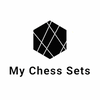Introduction to the Art of Chess Piece Carving
The game of chess is not only a battle of wits on the board but also a celebration of craftsmanship and artistry in the pieces used to play it. Chess pieces, or chessmen, have been crafted from a multitude of materials throughout history, including wood, stone, metal, and even glass. However, the real challenge and beauty often lie in the intricacies involved in carving these pieces, especially from wood. Each piece has its symbolic shape and design, demanding specific skills and attention to detail from the carver.
The Complexity of Chess Pieces: From Pawns to Kings
Each type of chess piece has its own level of complexity in terms of design and carving. Pawns, the smallest and most numerous pieces in the game, are often the simplest, characterized by a rounded top and a relatively straightforward shape. Rooks, with their castle-like structure, present a slight increase in difficulty, featuring battlements that require careful crafting. Knights, represented by a horse's head, introduce a challenge with their curved necks and detailed manes. Bishops, with their mitre-shaped tops, and Queens, with their coronet and often elaborate embellishments, further escalate the intricacy of the carver’s task. The King, usually the tallest piece with a cross atop his crown, combines complexity and stature, symbolizing his importance on the board.
Factors Influencing the Difficulty of Carving
Several factors influence the difficulty of carving chess pieces, including the material’s properties, the tools used, and the level of detail required in the piece’s design. Woods used in carving, like ebony, rosewood, and boxwood, each have different hardness and grain patterns which can affect the ease or challenge in carving. Additionally, the fineness of the details, such as facial features on the Knight or the ornate decorations on the Queen, require precision and could be demanding based on the carver's skill and experience.
The Knight: A Carving Challenge
Among all the chess pieces, the Knight stands out as particularly challenging to carve. This is not merely due to its iconic horse-head shape but also because of the piece’s dynamic posture and intricate details which are not symmetrical like the other pieces.
The Iconic Shape of the Knight
The Knight is unique, usually depicted mid-stride with one leg raised or in a stationary but alert stance, embodying a sense of readiness and valor. Unlike other pieces, the Knight's design is not vertically symmetrical, adding a layer of complexity to its carving. This asymmetry means the carver cannot simply replicate one side to the other; each side must be approached differently while maintaining balance and proportion suited to the piece’s aesthetic and functional roles on the chessboard.
Detailing the Knight
Detailing is where carving the Knight becomes especially challenging. A traditional Knight's mane, reins, eyes, mouth, and muscular structure of the neck all require exquisite detailing, making it not only a test of the carver’s skill in shaping but also in achieving expression and finesse. Each curve and cut need to convey the strength and grace of a horse, an animal renowned for both its power and beauty.
Tools and Techniques for Carving a Knight
The tools used to carve a Knight must allow for precision. Chisels, gouges, and knives of various sizes are typically employed to achieve the required depth and intricacy. Carvers may also use rotary tools for finer details, especially in harder woods. Beyond the tools, the technique of the carver plays a crucial role. Experienced carvers often use a combination of hand carving for major shapes and detailed tooling for the finer features, allowing them to control the expression and detail closely.
Master Carvers and the Knight
Master carvers often regard the Knight as the piece that allows them the most expressive range in the crafting of a chess set. It is not uncommon for chess enthusiasts and collectors to judge the quality of a chess set by examining the craftsmanship of the Knights. A well-carved Knight will not only display stunning artistry but also embody the carver’s individual style and interpretation, making each set unique.
Material Choices for Carving the Knight
In choosing materials for carving the Knight, craftsmen must consider both aesthetics and workability. Dense hardwoods like ebony and rosewood are favored for their fine grain and ability to hold detail, but they require skill to shape and finish. Softer woods may be easier to carve but can lack the definition needed to capture intricate details unless treated or finished with skill.
Conclusion: The Artistic Triumph of the Knight
The Knight, more than any other chess piece, represents a pinnacle of carving challenge and artistic expression in the world of chess. The combination of complex shape, detailed anatomy, and expressive potential makes the Knight a formidable project for any carver. Whether viewed as part of a set or as a standalone piece of art, a beautifully carved Knight speaks volumes about the traditions, skill, and creativity embedded in the ancient game of chess. Through the care and craftsmanship that goes into each piece, the art of chess carving continues to celebrate and advance the aesthetic and intellectual joy chess has offered for centuries.
Exploring Further
For those interested in exploring this craft, numerous resources are available, from detailed carving manuals to workshops and online tutorials focused on chess piece creation. Museums and historical exhibits that feature intricately carved chess sets also provide inspiration and context for what is possible in this meticulous and rewarding art form. Indeed, the journey through mastering the carving of a Knight could be as challenging and enriching as the game of chess itself.
Explore our large collection of beautiful chess sets!